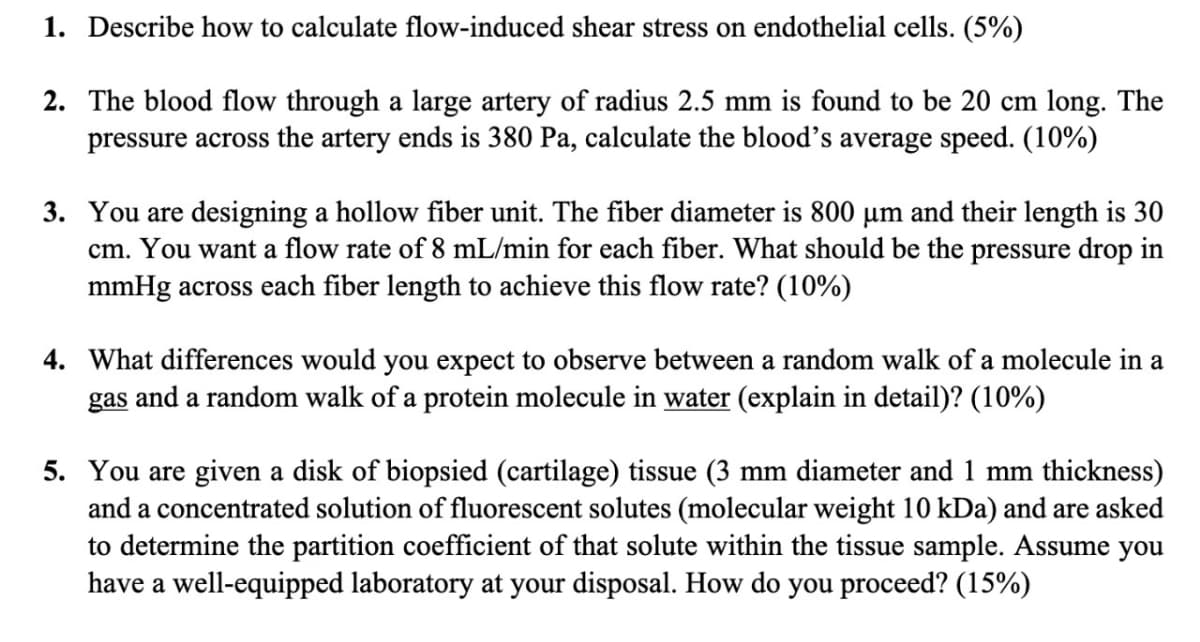3. You are designing a hollow fiber unit. The fiber diameter is 800 µm and their length is 30 cm. You want a flow rate of 8 mL/min for each fiber. What should be the pressure drop in mmHg across each fiber length to achieve this flow rate? (10%)
3. You are designing a hollow fiber unit. The fiber diameter is 800 µm and their length is 30 cm. You want a flow rate of 8 mL/min for each fiber. What should be the pressure drop in mmHg across each fiber length to achieve this flow rate? (10%)
Principles of Instrumental Analysis
7th Edition
ISBN:9781305577213
Author:Douglas A. Skoog, F. James Holler, Stanley R. Crouch
Publisher:Douglas A. Skoog, F. James Holler, Stanley R. Crouch
Chapter27: Gas Chromatography
Section: Chapter Questions
Problem 27.22QAP
Related questions
Question
Please send me the question in 20 minutes it's very urgent plz....only question number 3

Transcribed Image Text:1. Describe how to calculate flow-induced shear stress on endothelial cells. (5%)
2. The blood flow through a large artery of radius 2.5 mm is found to be 20 cm long. The
pressure across the artery ends is 380 Pa, calculate the blood's average speed. (10%)
3. You are designing a hollow fiber unit. The fiber diameter is 800 µm and their length is 30
cm. You want a flow rate of 8 mL/min for each fiber. What should be the pressure drop in
mmHg across each fiber length to achieve this flow rate? (10%)
4. What differences would you expect to observe between a random walk of a molecule in a
gas and a random walk of a protein molecule in water (explain in detail)? (10%)
5. You are given a disk of biopsied (cartilage) tissue (3 mm diameter and 1 mm thickness)
and a concentrated solution of fluorescent solutes (molecular weight 10 kDa) and are asked
to determine the partition coefficient of that solute within the tissue sample. Assume you
have a well-equipped laboratory at your disposal. How do you proceed? (15%)
Expert Solution
This question has been solved!
Explore an expertly crafted, step-by-step solution for a thorough understanding of key concepts.
This is a popular solution!
Trending now
This is a popular solution!
Step by step
Solved in 2 steps with 2 images

Knowledge Booster
Learn more about
Need a deep-dive on the concept behind this application? Look no further. Learn more about this topic, chemistry and related others by exploring similar questions and additional content below.Recommended textbooks for you

Principles of Instrumental Analysis
Chemistry
ISBN:
9781305577213
Author:
Douglas A. Skoog, F. James Holler, Stanley R. Crouch
Publisher:
Cengage Learning

EBK A SMALL SCALE APPROACH TO ORGANIC L
Chemistry
ISBN:
9781305446021
Author:
Lampman
Publisher:
CENGAGE LEARNING - CONSIGNMENT


Principles of Instrumental Analysis
Chemistry
ISBN:
9781305577213
Author:
Douglas A. Skoog, F. James Holler, Stanley R. Crouch
Publisher:
Cengage Learning

EBK A SMALL SCALE APPROACH TO ORGANIC L
Chemistry
ISBN:
9781305446021
Author:
Lampman
Publisher:
CENGAGE LEARNING - CONSIGNMENT
